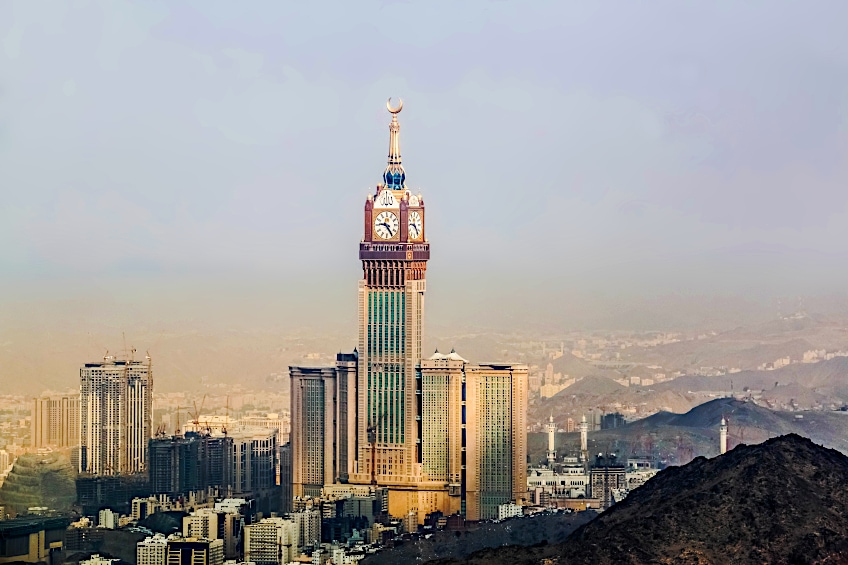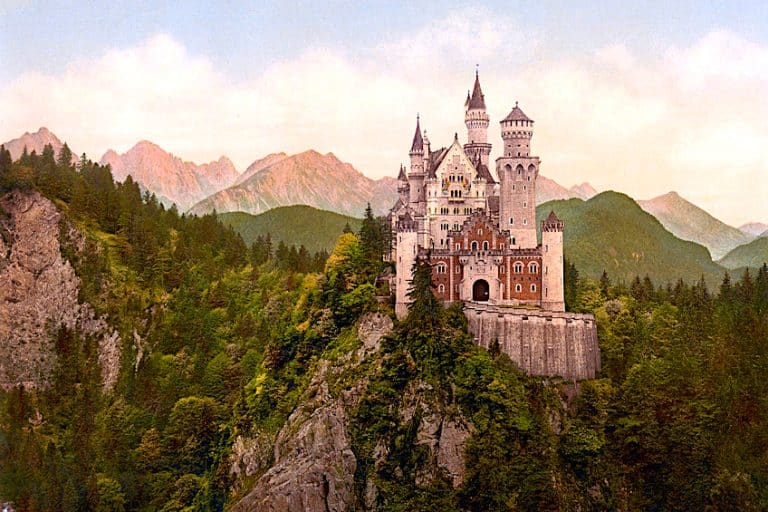Makkah Royal Clock Tower – Tallest Clock Tower in the World
Where is the world’s tallest clock tower? The Makkah Royal Clock Tower in Saudi Arabia is regarded as the biggest around the globe. The giant clock tower is situated in Abraj Al Bait, a seven-tower complex owned by the government of Saudi Arabia. These skyscrapers are a component of the Endowment Project of King Abdulaziz, which plans on enhancing the city’s pilgrimage facilities.
Table of Contents
The Makkah Clock Royal Tower in Saudi Arabia
| Architect | The SL Rasch GmbH Special and Lightweight Structures (est. 1980) |
| Date Completed | 2012 |
| Function | Mixed-use |
| Location | Mecca, Saudi Arabia |
The Makkah Clock Royal Tower in Saudi Arabia is the world’s fourth-highest structure. The Clock Tower Museum, which occupies the top four floors of the edifice, is housed in the clock tower. The huge building is only a few meters away from Mecca’s Great Mosque, the world’s largest mosque, and Islam’s holiest site.

The project was developed and built by the Saudi Binladin Group, the Kingdom’s largest construction company. It is the world’s second most costly structure, with an overall development cost of US$15 billion.
The complex was built on the site of the Ajyad Fortress, an 18th-century Ottoman fortification on top of a hill facing the Grand Mosque. The Saudi government’s demolition of the historically valuable landmark in 2002 drew outrage and a strong response from Turkey.
Description
The structure’s architectural design is Postmodernist New Classical, which is similar to a large portion of the architecture of the fast-growing capitalist country’s urban fabric.
At 600 meters in height and an overall surface area of more than 31,000 square meters, the complex’s highest tower is the tallest structure in Saudi Arabia.
It is now the world’s sixth-highest skyscraper, beating Shenzhen’s Ping An Finance Centre located in China, but falling short of Dubai’s renowned Burj Khalifa. The complex’s location is across the plaza to the southern end of the entrance gate of the Masjid al-Haram Mosque, which contains the Kaaba. It serves to provide accommodation for those who wish to visit the Kaaba.

The highest tower in the complex also has a five-star hotel to accommodate the millions of pilgrims who visit Mecca each year to perform the Hajj. The Clock Towers also contains a five-story commercial shopping complex and a parking garage that can accommodate over a thousand cars. In 2006, the structure was set to be 734 meters tall. It was announced in 2009 that the total elevation would be 601 meters. Premiere Composite Technologies built the facade, while PERROT, a German tower clock company, built the clock.

Clocks
The clock itself is 57 meters tall, and clock faces are visible on each side of the main hotel tower. These are the world’s biggest, measuring 43 meters by 43 meters. The clocks’ roof is 450 meters above surface level, making them the world’s highest architectural clocks. The clock now stands 601 meters tall thanks to the addition of a spire on top.
There is an astronomical installation behind the clock faces. There is a scientific facility in the spire’s foundation and floors that is utilized to view the moon at the start of the Islamic months and to run an atomic clock that governs the calendar.

Every one of the clock’s faces is backlit by around two million little LED lights, which includes four ledges, directly above the clock with massive calligraphy reading: “Allah is the greatest” in Arabic on the south and north faces, and “Allah is the only god” on the east and west faces. There are also four gilded domes atop pillars at each corner. At the very top of the clock is the Saudi flag, which flashes to indicate Islam’s several daily prayers.
On significant occasions, such as New Year’s Eve, 21,000 white xenon and green bulbs, as well as LED lighting, is lit as well as during the five daily calls to prayer.

On exceptional occasions, 40 beacon lights allow for countless variants of magnificent illumination shows. Furthermore, the world’s four most powerful display lasers shoot their beams 30 kilometers into the air. The four faces of the clock are decorated with around 99 million glass mosaic pieces. Behind the dials, the Saudi’s coat of arms is placed in the middle of each clock. The hand that denotes the minutes is 23 meters long, while the hour hand measures 18 meters.
It was rumored that the clock was going to be changed to represent local Mecca Time, supplanting the Reference Meridian as the primary meridian for world timekeeping, however, it is currently still set to Arabic Standard Time.
The facades’ pointed arches and Islamic embellishments are covered with gilded mosaic tiles. According to a feature story on the Makkah Royal Clock Tower in the Guardian, the trellis screens that were created are modeled on the mashrabiya panels that usually consist of latticework. However, they do not provide any function or ventilation but was added solely for aesthetic value.
The Spire
The spire features a glass-covered base eight stories high that houses a research center with its own little exhibition, as well as another viewing deck at 484 meters. The Control Tower Level is The Jewel’s highest floor, and it was intended to be used for managing air traffic in the skies over Mecca – mostly helicopters, as airplanes are not permitted near Mecca. Nevertheless, due to technical concerns, the plan was abandoned, and the future application of the structure remains unknown.
The spire above The Jewel contains mainly equipment for light, sound, and other infrastructure, as well as the last observation deck and the crescent moon sign above it.
There are two standard stories with living spaces plus a few maintenance floors and rooms in the crescent. Premier Composite Technologies built the crescent moon on the top in April 2011. The crescent is constructed of fiberglass-backed mosaic gold and weighs around 35 tons.

Peugeot Joseph, a company representative, stated that the construction, which cost 90 million UAE dirhams and took three months to complete, was completed by a group of five engineers and a hundred laborers. To transport the crescent to Mecca, it was broken into ten separate pieces. To minimize the crescent to 5 components, it was partially constructed on the base of the clock face. These five components were then raised and placed above the spire.
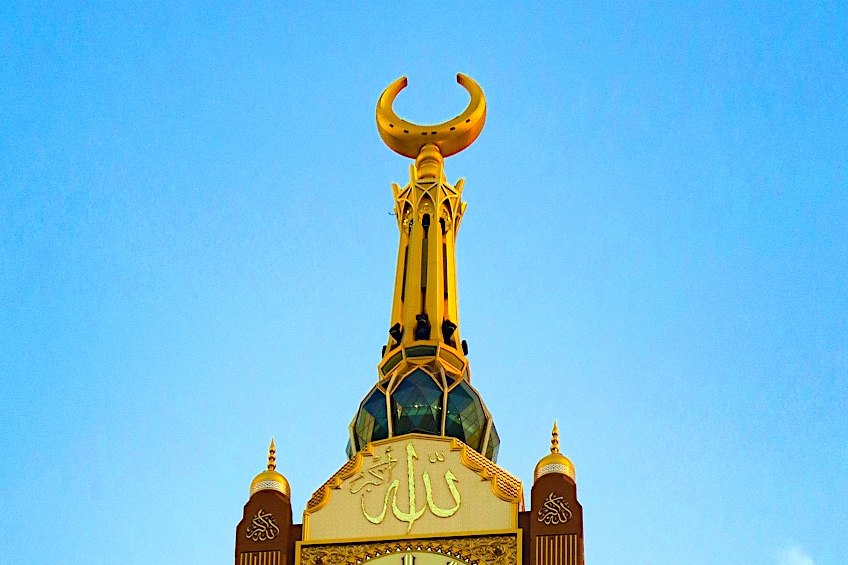
The minaret and its base are equipped with loudspeakers that transmit prayer calls that can be heard up to 7 kilometers away and throughout an area of roughly 160 square kilometers.
The 6-tonne crescent moon at the summit of the Makkah Royal Clock Tower stands out against the backdrop and can be observed from the plaza below. The gigantic piece has a diameter of 21 meters and has a monocoque construction, which means that the piece’s loads are sustained by the structural skin. A four-story-high column-free living area with a lounge, a prayer room, a bathroom, a kitchen, and a few service levels comprise the crescent.
Construction and Materials
The moon crescent atop the Makkah Royal Clock Tower is composed of carbon fiber and covered in more than 1,100 square meters of gold mosaic. The monocoque component raised the spire from 580 meters to 601 meters.
The design firm SL Rasch worked with a boatbuilding business to find out how to assemble the clock from carbon fiber and high-strength glass to withstand strong wind forces and the weight of the building itself.
The massive clock is made up of 600 glass fiber-reinforced panels and 98 million glass mosaic tiles in six distinct colors. The whole structure of the clock is self-supporting, with no load-bearing chambers. Given the wind forces and the immense weight of the clock’s parts, the clock’s operation was critical.

The Makkah Royal Clock Tower in Saudi Arabia is a concrete construction with a steel framework that goes all the way to the top. The building’s load-bearing foundation is made up of four V-shaped support beams. The columns taper and join with the cylindrical steel beams just above the clock tower.
The Complex
The complex is a residential facility and hotel located just a few hundred meters from Mecca’s Holy Mosque. The smaller constructions to the side of the Clock Tower also serve as hotels, and several of the other towers feature helipads. The tower houses a number of hotel rooms, a five-story commercial center, prayer rooms, and a museum dedicated to all capped off with a golden crescent. The symmetrical building stands over the plaza and the Kaaba, and the clock shows the hour for prayers across the country.

A prayer chamber is located directly under the crescent and can only be reached from the top level of the structure by an 18-meter spiral staircase or the auxiliary chairlift. After winding it seven times, the chairlift may reach the prayer chamber. At night clock indicates the time for prayers. The two million LED lights on the clock faces are powered by a hollow cavity behind the clock area.
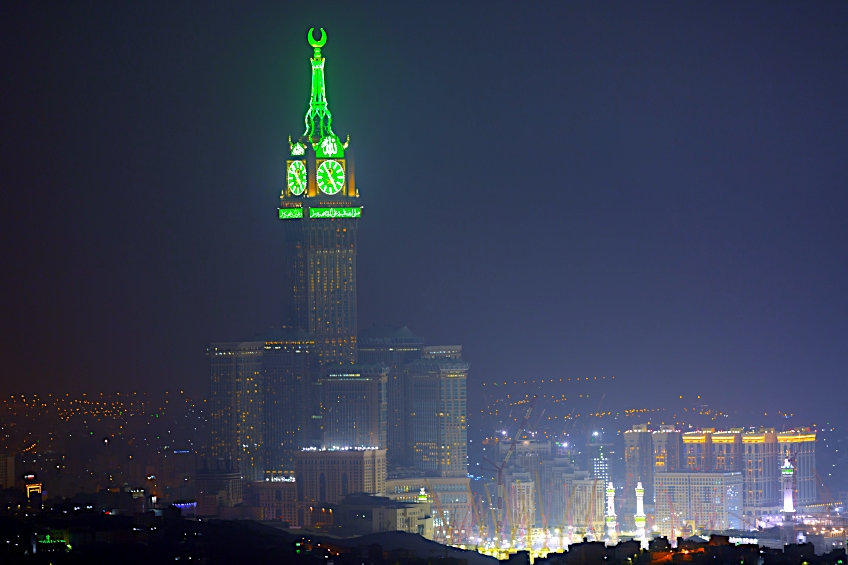
The Makkah Royal Clock Tower’s lower five stories are commercial complexes. The rest of the structure, underneath the clock, houses a multitude of luxury hotels. The Abraj Al-Bait complex as a whole has 858 suites managed by many prominent worldwide star hotel brands, with the Makkah Royal Clock Tower housing 864 of them.
Although this government-owned facility was first created to cater to Mecca’s booming pilgrim-tourist population, a considerable number of the buildings remain vacant due to the prohibitively expensive hotels and dwellings.
The capitalist country’s strategy of erecting high constructions by demolishing holy sites and mountains in the area has sparked widespread condemnation from international communities.
Sustainability of the Giant Clock Tower
More than 230 solar panels in purple and blue colors were custom-cut to form the curving section of the spire atop The Jewel. The solar panels, which comprise 11,000 separate photovoltaic cells, fuel the four clock components. Because glass mosaic tiles make up a large amount of the Makkah Royal Clock Tower’s exterior, it was critical to select materials that would be less impacted by the massive diurnal temperature differences of up to 158 degrees Fahrenheit (70 degrees Celsius).
Glass mosaic tiles were utilized because UV rays are reflected by them efficiently.
Because Mecca is a particularly keraunic environment, lightning protection techniques of the Makkah Royal Clock Tower were critical. This system, which includes over 800 fixed lightning conductors, protects the structure from regular lightning hits.
Incidents and Controversy
During the building of the Clock Towers complex, there were two fires. The first fire occurred on the 28th of October, 2008, at Hajar Tower. The fire, which lasted for 10 hours and consumed nine levels of the tower, required more than 400 firemen to extinguish. Eyewitnesses said that the fire started just after midnight and swiftly spread owing to building materials kept on the site. The complete structure suddenly became engulfed in smoke. Despite the fact that hospitals were put on heightened alert, no injuries were reported. According to a civil defense spokesperson, the fire erupted on the 32nd story of the Hajar Tower.
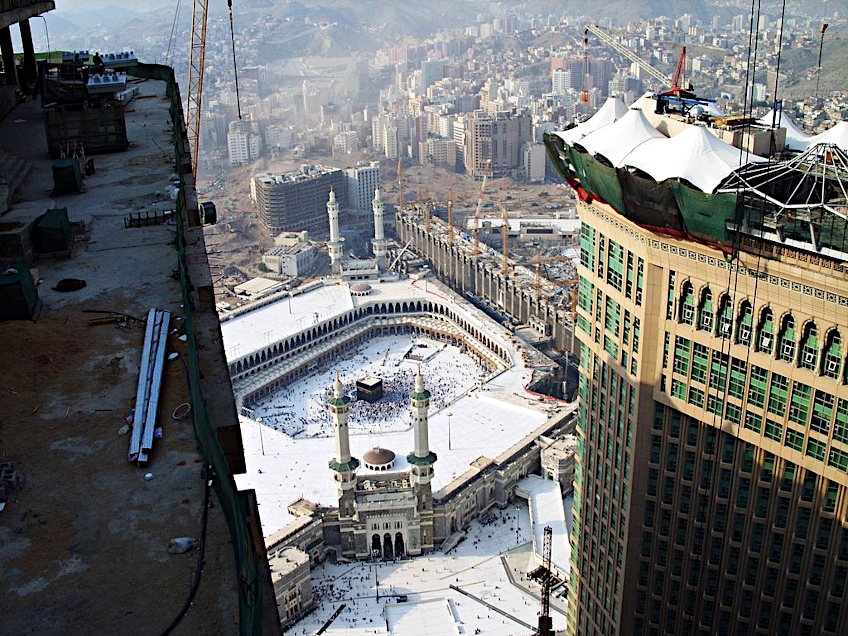
On the 1st of May, 2009, a second fire broke out at the Safa Tower. The fire, which was immediately extinguished by Civil Defense, caused no injuries or deaths. According to witnesses, the fire started shortly after prayer as several employees in the structure were welding iron rods on timber scaffoldings. A major portion of the under-construction skyscraper was destroyed by the fire. According to the director general of Civil Defense in Mecca, Major General Adel Zamzami, the fire started on the 14th story and spread to the 20th.
The Guardian criticized the development for “transforming a sort of architecture that grew from a dense urban fabric of low-rise courtyards and small alleyways into an endlessly repetitive pattern of standardized concrete slabs.”
The towers generated heated criticism from the international community too since they were erected on the site of the famed Ottoman Ajyad Fortress, which was demolished to make way for the sprawling complex. However, many residents regard the citadel as a relic of Ottoman oppression.
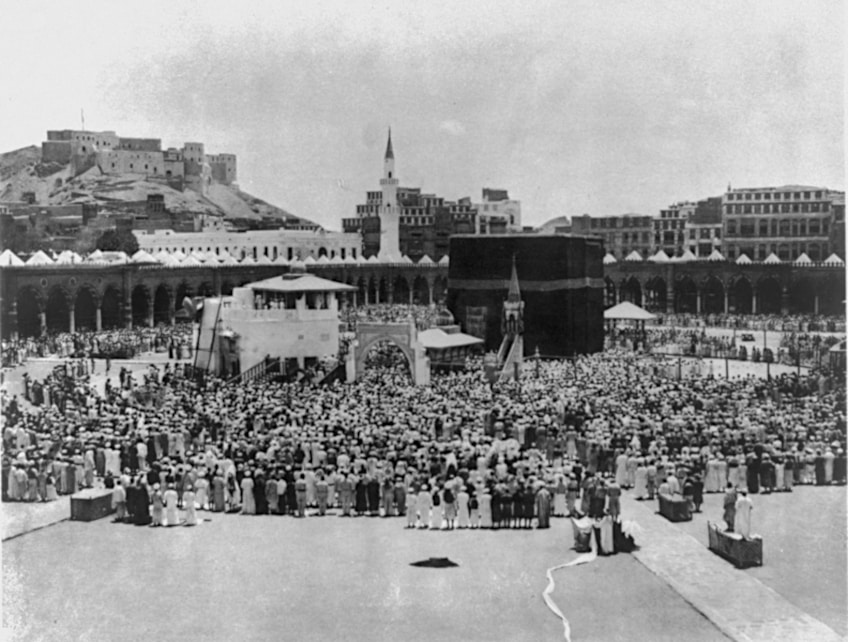
The demolition of the fortress sparked tension between Muslim countries Turkey and Saudi Arabia. The 222-year-old Al Ajyad stronghold was demolished as part of a campaign aimed at eliminating monuments from earlier times of Islam in order to stop them from becoming destinations of pilgrimage.
According to some experts, the program expected pressures from Western countries and certain Muslim countries for a more liberal view of Islam, which promotes a form of Islam that condemns popular displays such as shrine adoration and regional pilgrimages as idolatry.
The Turkish Culture Minister linked the Saudi proposal to the Taliban’s demolition of two massive medieval Buddha sculptures sculpted into the mountainside of Bamiyan in central Afghanistan. He believed that cultural heritage was public possession in every country, regardless of its origin or the time in which it was erected, and that cultural heritage ought to be conserved. However, Saudi authorities were reported as declaring that the fortress was not a sacred place and that its destiny was thus entirely in Saudi hands.
Despite the negative reactions to the development of the Abraj Al-Bait complex, the Makkah Royal Clock Tower stands towering in the heart of the Holy Mecca, directly near the Kaaba, as an imposing monument amid the packed narrow alleyways filled with courtyards of the surrounding urban fabric. Despite symbolizing the state’s current and rising economic imbalance, the Islamic iconography shown on the exterior promotes humility and the interior promotes sustainability. No matter what our opinions on the matter, one cannot deny the beauty and magnificence of the Abraj Al Bait complex and its giant clock tower.
Frequently Asked Questions
Where Is the World’s Tallest Clock Tower?
It is located in Saudi Arabia at the Abraj Al Bait complex of skyscrapers. The clock tower structure is the biggest of seven other high-rise buildings that comprise the complex. A unique feature of the clock tower is its proximity to the holy site of Mecca which people flock to annually for their pilgrimage. As Saudi Arabia is an Islamic country, they are called to prayer several times a day, and the clock not only tells the time but also calls the faithful to prayer. Right at the top of the clock tower is a structure in the shape of a crescent moon. It is not only there for aesthetic purposes though, and actually contains several different sections comprising storage rooms, office space, a lounge, a kitchen, and a small study.
Why Was There Controversy Surrounding the Building of the Abraj Al Bait Complex?
The Makkah Royal Clock Tower in Saudi Arabia was actually built on the site of an old Ottoman-era fortress. Many Islamic countries, specifically Turkey, were not happy about the destruction of what they viewed as an important historical edifice that should have been preserved. However, the Saudis felt that the structure was a symbol of Ottoman rule and as it was not a religious building, it was their decision what happened to it.
Justin van Huyssteen is a freelance writer, novelist, and academic originally from Cape Town, South Africa. At present, he has a bachelor’s degree in English and literary theory and an honor’s degree in literary theory. He is currently working towards his master’s degree in literary theory with a focus on animal studies, critical theory, and semiotics within literature. As a novelist and freelancer, he often writes under the pen name L.C. Lupus.
Justin’s preferred literary movements include modern and postmodern literature with literary fiction and genre fiction like sci-fi, post-apocalyptic, and horror being of particular interest. His academia extends to his interest in prose and narratology. He enjoys analyzing a variety of mediums through a literary lens, such as graphic novels, film, and video games.
Justin is working for artincontext.org as an author and content writer since 2022. He is responsible for all blog posts about architecture, literature and poetry.
Learn more about Justin van Huyssteen and the Art in Context Team.
Cite this Article
Justin, van Huyssteen, “Makkah Royal Clock Tower – Tallest Clock Tower in the World.” Art in Context. January 13, 2023. URL: https://artincontext.org/makkah-royal-clock-tower/
van Huyssteen, J. (2023, 13 January). Makkah Royal Clock Tower – Tallest Clock Tower in the World. Art in Context. https://artincontext.org/makkah-royal-clock-tower/
van Huyssteen, Justin. “Makkah Royal Clock Tower – Tallest Clock Tower in the World.” Art in Context, January 13, 2023. https://artincontext.org/makkah-royal-clock-tower/.


